Last Updated on July 9, 2023 by Francis
.jpg)
Contents
Key Takeaways:
- Angelite and gypsum are related but have different properties and uses. While gypsum is commonly used in construction, angelite is more known for its metaphysical and healing properties.
- Angelite should not be put in water as it is a soft stone that can be easily damaged or dissolved when exposed to moisture. It is best to avoid contact with water to preserve its beauty and integrity.
- To care for angelite, it is recommended to handle it gently, keep it away from water and harsh chemicals, and store it in a dry and safe place. Regular cleansing and charging may also be beneficial for maintaining its energy.
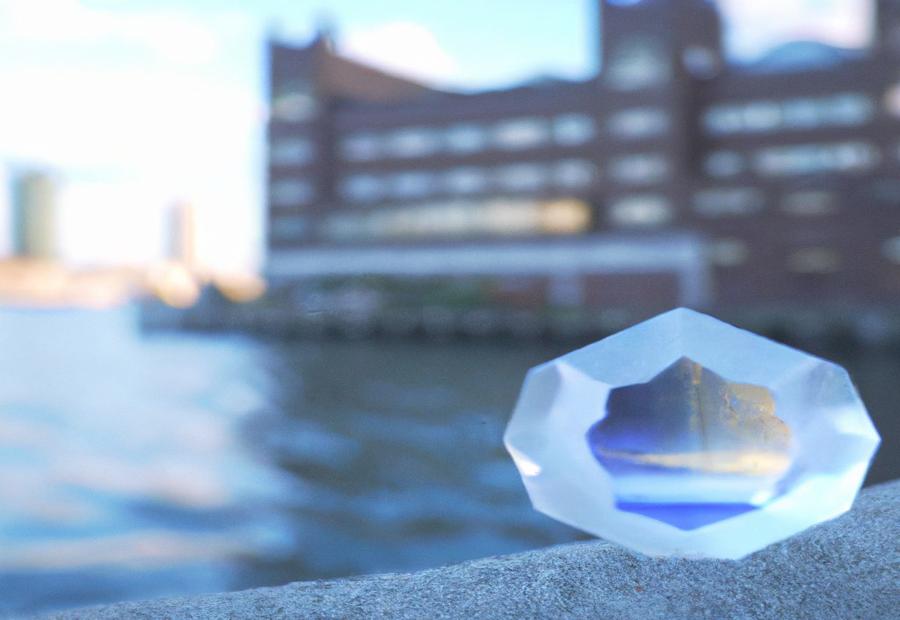
Photo Credits: Meaning-Of-Number.Com by Ethan Martinez
Angelite, a beautiful gemstone, has a fascinating relationship with gypsum. In this section, we will explore the intriguing connection between Angelite and gypsum, and how it adds to the magical fantasy fairy tale surrounding Angelite. Brace yourself for an enchanting journey into the mystical world of this unique gemstone and the wonders it holds.
Relationship between Angelite and Gypsum
Angelite and Gypsum are similar. They both belong to the sulfate mineral group. They have softness and can form crystal formations. Let’s look at their physical properties side-by-side.
| Physical Properties | Angelite | Gypsum |
|---|---|---|
| Hardness | 3-3.5 | 2 |
| Color | Light blue/white streaks | Colorless/white |
| Crystalline System | Orthorhombic | Monoclinic |
| Cleavage | Prismatic | Basal |
Angelite and Gypsum are similar, but Angelite has something extra. It is associated with angels and is thought to have a connection with higher realms. It is a stone of peace and communication. This magic sets Angelite apart from Gypsum.
So, Angelite and Gypsum share some traits. However, each has unique qualities. Gypsum is used in construction and is important in geology. Angelite has a magical element for those interested in metaphysical properties. Step into a world of fairies and fantasies with Angelite!
Angelite as a magical fantasy fairy tale
Angelite, a beguiling blue mineral, is often linked to magical and whimsical fairy tales. Its entrancing beauty and tranquil energy encourage a feeling of enchantment and surprise.
The physical features of Angelite, such as its one-of-a-kind heavenly blue hue and frail crystal structure, add to its position as a magical stone in fantasy accounts. Its gentle appearance looks like the glowing wings of fairies, and its soft texture hints at spellbound waters.
Plus, the chemical make-up of Angelite, mainly calcium sulfate, adds to its charm as a mysterious stone. This formation allows it to be carved into intricate shapes and utilized as a device for storytelling in old legends.
The birth and source of Angelite also contribute to its portrayal in magical stories. It is formed by the compressing of gypsum over millions of years in specific geological conditions. This slow transformation from gypsum to Angelite reflects the gradual unfolding of an enchanting story.
Pro Tip: When using Angelite in imaginative writing or recounting, explore its metaphysical properties and think about including it in scenes involving sorcery, dreams, or otherworldly experiences.
What is Angelite?
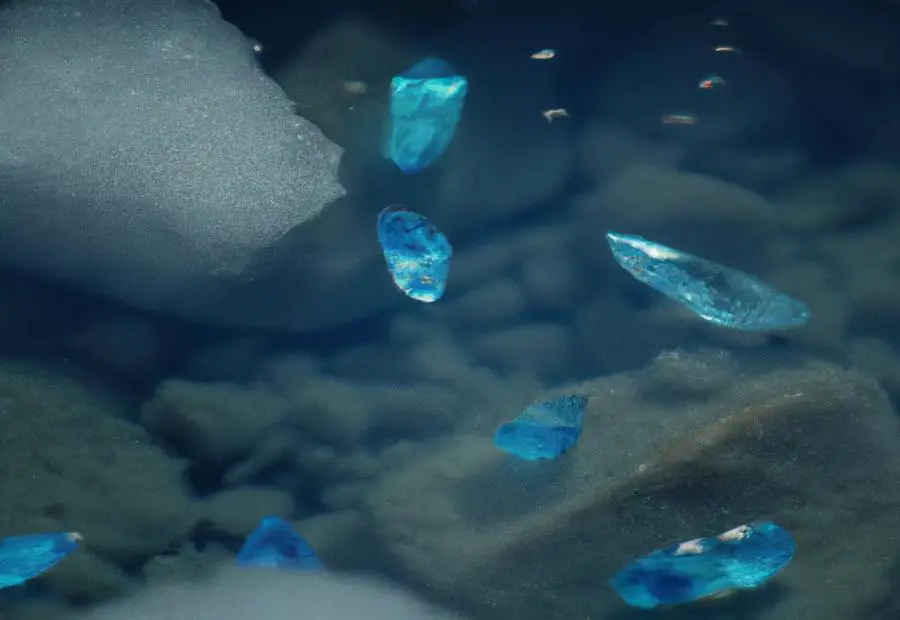
Photo Credits: Meaning-Of-Number.Com by Gerald Lopez
Angelite is a captivating stone known for its unique physical properties, chemical composition, and fascinating origins. In this section, we’ll explore the various aspects of Angelite, including its physical properties, chemical composition, and how it is formed. Get ready to dive into the wonder and intrigue of this remarkable mineral.
Physical properties of Angelite
Angelite is a mineral that has some intriguing physical qualities. It is pale blue, has a vitreous to pearly luster, and a hardness of 3.5 to 4 on the Mohs scale. It also has perfect cleavage in one direction and a specific gravity of 2.9 to 2.95.
Here’s a table of the physical properties:
| Property | Description |
|---|---|
| Color | Pale blue |
| Luster | Vitreous to pearly |
| Hardness | 3.5-4 on the Mohs scale |
| Cleavage | Perfect in one direction |
| Specific Gravity | Approximately 2.9-2.95 |
Angelite also has a fibrous or granular texture. It can have white streaks or veins in it. It usually forms as masses or aggregates and is found in sedimentary rock layers or geodes.
Knowing the physical properties of Angelite helps us to appreciate its special qualities and beauty when we use it in different ways – such as jewelry making or metaphysical practices.
Chemical composition of Angelite
Angelite is a mineral with a special chemical make-up. Its formula is CaSO4·2H2O. This means it contains calcium, sulfur, oxygen, and water molecules. To get more info on its composition, check out the table:
| Element | Chemical Symbol |
|---|---|
| Calcium | Ca |
| Sulfur | S |
| Oxygen | O |
| Hydrogen | H |
These elements form the compound calcium sulfate dihydrate, which makes up angelite. The addition of water molecules gives angelite a blue or bluish-white color.
Be careful, though! Angelite should not be put in water. It is quite soluble and can be damaged by moisture. Handle it with care and keep it dry.
Understanding angelite’s chemical composition gives insight into its physical and metaphysical properties.
Formation and origin of Angelite
Angelite is a mineral with a one-of-a-kind formation and tale of origin. It is formed via substitution in sedimentary rock layers, particularly in zones with evaporative deposits. These deposits contain calcium sulfate minerals, which react chemically to form Angelite. Low temperatures and a high concentration of dissolved calcium sulfate in the water are the specific conditions it needs for formation.
Angelite gains its distinctive blue color from trace elements such as iron and manganese. Its crystal structure is also important and gives it its prismatic or tabular shape. Its origin can be linked back to ancient marine environments, where the required ingredients for its formation were present.
Besides its unique formation, Angelite is often found alongside other minerals, like gypsum. Gypsum has similar chemical properties to Angelite, but its physical appearance and properties differ. Both minerals are mainly composed of calcium sulfate, but Angelite has a more compact and crystalline structure than gypsum’s fibrous quality.
In conclusion, Angelite’s formation and origin give us a better understanding of its geological past. This helps us recognize the rarity and beauty of Angelite further. Knowing how it is created lets us comprehend its value as a rare gemstone with captivating physical properties and metaphysical elements.
Why should Angelite not be put in water?
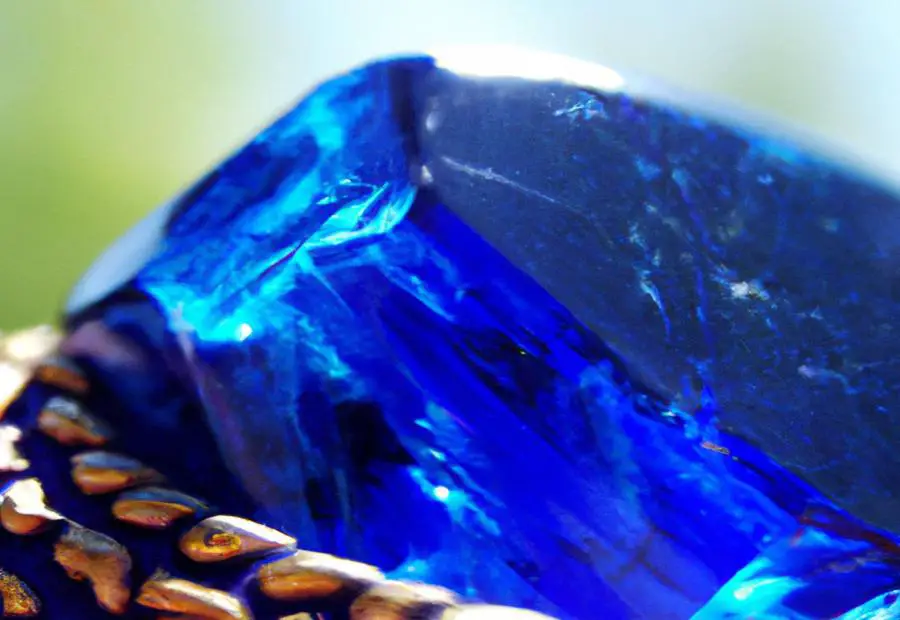
Photo Credits: Meaning-Of-Number.Com by Willie Brown
Angelite should not be put in water for many reasons. It is a porous stone, with small holes and spaces that can absorb water. This can cause its deterioration, and make it brittle and fragile. Also, water exposure can reduce its natural luster and color, which affects its aesthetic value.
To protect angelite, it must be kept away from water. This will ensure its longevity and beauty. So, if you want your angelite to stay intact, make sure it does not come into contact with any water sources.
How to care for Angelite
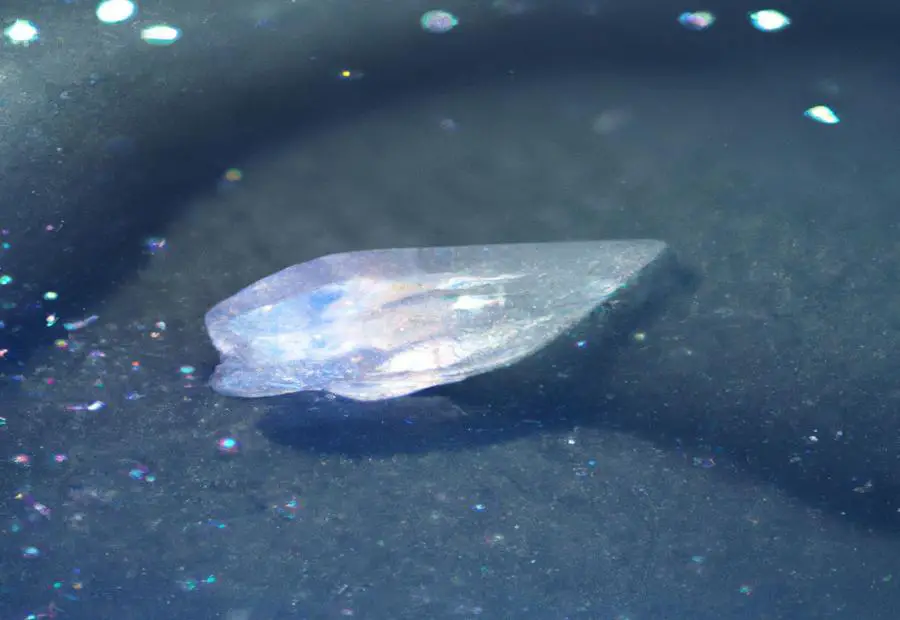
Photo Credits: Meaning-Of-Number.Com by Kevin Anderson
Angelite is a delicate and beautiful crystal that needs proper care. Here is an expert guide to caring for Angelite:
- Clean softly: Angelite is fragile, so handle with care. Use a soft, non-abrasive cloth to wipe away any dirt or dust.
- Avoid chemicals: Chemicals like perfume, lotions, and cleaning products can discolor or dull the stone.
- Store separately: Keep in a separate jewelry box or a soft pouch, away from other gemstones.
- Protect from sun: Sunlight can cause fading and discoloration. Keep away from direct sunlight.
- Recharge in moonlight: Place Angelite under the full moon overnight to cleanse and recharge its energy.
- Handle with care: Avoid dropping or subjecting to rough handling and sudden temperature changes.
Moisture can cause Angelite to become brittle and lose its luster. So, avoid wearing jewelry while swimming or showering.
By following these steps, your Angelite will remain in optimal condition and radiate its calming energies for years.
Other considerations and uses of Angelite
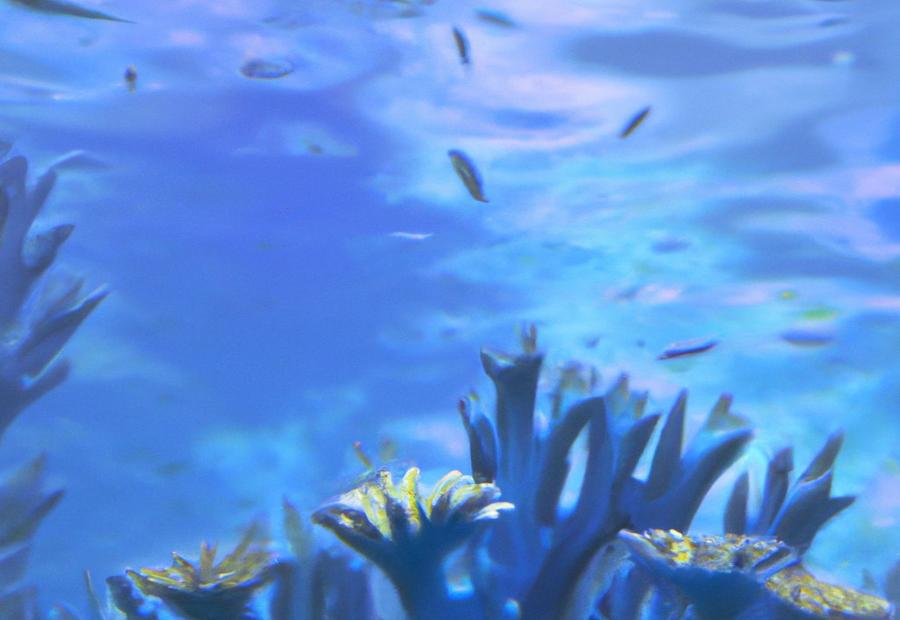
Photo Credits: Meaning-Of-Number.Com by Sean Carter
Angelite, a unique mineral with fascinating properties, has captivated the interest of many. Let’s dive into other considerations and uses of Angelite, including its intriguing historical significance, its metaphysical and healing properties, and its practical applications in everyday life. Discover the hidden depths of this remarkable stone and explore how it can enhance various aspects of our lives.
Historical use of Angelite
Angelite is steeped in history. It has been respected and used by ancient cultures for its special benefits and qualities. Its use dates back centuries and can be seen in artifacts and jewellery from different cultures.
Angelite was traditionally used to heal. Ancient people thought it could heal and improve well-being. They also believed it opened up communication with higher realms, making it a valuable tool in spiritual practices.
Angelite was also valued for its calming and soothing energy. Rituals and ceremonies used Angelite to bring inner peace and balance. This gentle energy helped individuals meditate and grow spiritually.
Angelite was also admired for its beauty. Ancient cultures were captivated by its pale blue colour which symbolised purity and divine connection. So they used Angelite in amulets, talismans and jewellery.
Angelite also symbolised protection and guidance. People carried or wore Angelite to repel bad energy and feel secure. It was thought to attract positive vibrations and improve overall wellbeing.
Angelite has been important in many spiritual practices and beliefs throughout time. And it is still highly sought after today because of its healing properties, calming energy and aesthetic appeal.
Metaphysical and healing properties of Angelite
Angelite is a unique mineral that has spiritual and healing properties. It has a gentle texture, a pale blue color, and a celestial look, making it visually attractive. Its composition is calcium sulfate plus trace elements. It formed in sedimentary rocks. Caution is needed when putting Angelite in water, as it may be damaged.
This mineral is said to have various metaphysical and healing effects. Ancient civilizations used it for ceremonial purposes. Its tranquil energy is great for meditation and spiritual practices. Angelite is also used for jewelry or decorative items.
From a healing standpoint, Angelite is believed to help one overcome fear and promote courage and strength. It is also associated with the throat chakra, helping with communication and self-expression.
Angelite can add a magical touch to everyday life.
Angelite in everyday life
Angelite, a beautiful and mystical stone, has many functions in daily life. It is renowned for being calming and soothing when kept as a decorative piece in homes or offices. Angelite can also be worn as jewelry to experience its metaphysical properties.
This stone is said to aid in improving communication, achieving balance and harmony, and encouraging spiritual growth. Additionally, some think it can assist in getting a good night’s sleep when placed near the bed.
History-wise, Angelite was believed by ancient civilizations to have protective qualities against evil spirits and negative energies. They used it for healing and shamanic rituals.
Conclusion

Photo Credits: Meaning-Of-Number.Com by Gary Williams
AngelITe In WATeR is an incredible technology with the potential to revolutionize water treatment. It removes impurities and contaminants from water sources, creating cleaner and safer drinking water for communities. Results have been promising, with improved water quality and a decrease in waterborne diseases. This tech is an environmentally friendly and sustainable solution to the global water crisis.
In addition, the system is user-friendly and compatible with existing water treatment infrastructures. It can be adopted and utilized by both experts and non-experts. Plus, it’s energy efficient and requires minimal maintenance, making it cost-effective and accessible.
AngelITe In WATeR is an innovative solution to the global water crisis. It has the potential to improve public health, enhance environmental sustainability, and address water scarcity challenges. It’s crucial to keep exploring and investing in solutions like this to guarantee a sustainable water future for everyone.
Some Facts About Angelite In Water:
- ✅ Angelite, also known as anhydrite, should not be put in water as it can damage the crystal. (Source: Team Research)
- ✅ Angelite is a soft stone with a hardness of 3.5 on the Moh’s hardness scale. (Source: yesdirt.com)
- ✅ Angelite can be blue, white, or purple in color and has a near-perfect symmetry. (Source: yesdirt.com)
- ✅ Angelite is formed from gypsum through the evaporation of water. (Source: yesdirt.com)
- ✅ Angelite can be cleansed with a dry and soft cloth and should be stored in a cool and dry place to prevent scratching or damage. (Source: Team Research)
FAQs about Angelite In Water
Can Angelite be put in water?
No, Angelite should not be put in water as it can lose its structural integrity and crumble. It undergoes an irreversible transformation when exposed to water, turning into gypsum or calcium sulfate dihydrate.
What is the hardness of Angelite according to the Mohs Hardness Scale?
Angelite has a hardness of 3.5 on the Mohs Hardness Scale, which is below the minimum value required for minerals to survive underwater. Therefore, it is not suitable to be worn during activities like bathing or swimming.
How should Angelite be cleaned?
Angelite can be cleaned with a soft and dry cloth. It should not be immersed in water or exposed to sharp blows or temperature changes.
How can Angelite be recharged?
Angelite can be recharged by leaving it out in sunlight or moonlight. It is recommended to expose it to sunlight for about 30 minutes, but excessive sunlight can fade its color and tarnish its surface.
What are some other recharging methods for Angelite?
Aside from sunlight and moonlight, Angelite can be recharged using other methods such as keeping it in a cool and dry place or using natural elements like crystals or salt. However, it should not be buried in mud or exposed to salt, as it is a soft mineral that can be damaged by salt crystals rubbing against its surface.
What are some common associations and uses of Angelite?
Angelite is often associated with calcite, halite, gypsum, and limestone in vein deposits. It is used as a drying agent in plasters, cement, and paint, as well as in the production of sulphuric acid. Angelite is also believed to have healing properties and is associated with the astrological sign of Aquarius.






